
Orangeville is a village in Stephenson County, Illinois. The town's sign lists the population at 800 as of January 2021. The population in 2020 was 738. The population according to the 2010 census was 793, up from 751 in 2000. Using the 2020 population of 738 Orangeville is the 741st largest city in Illinois and the 11,650th largest city in the United States. Orangeville is currently declining at a rate of -0.94% annually and its population has decreased by -6.94% since the 2010 census. The area's earliest white settlers arrived in the year 1833, and the village was platted in 1851 by John Bower, who is considered the village founder. In 1867 Orangeville was incorporated as a village. The town's central business district contains several 19th century commercial buildings, many of which were built during the railroad boom of 1888–1914. By the time the Great Depression was ongoing, business in Orangeville had started to decline, with the last bank closing in 1932. In 1956 another bank started operating in the village and is still in town today. Some recent infrastructure jumps have restored some of the village's old decor.
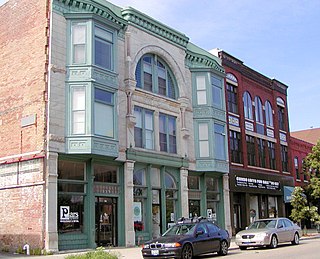
The Bloomington Central Business District is a historic district in downtown Bloomington, Illinois. The district includes roughly twelve square blocks of the city and encompasses 140 buildings, 118 of which are contributing buildings to the district's historic character. The 1901 McLean County Courthouse, the center of government of McLean County, is the focal point of the district. The other buildings in the district were built between 1842 and 1942 and are primarily commercial. The Miller-Davis Law Buildings, two of the oldest buildings in the district, were built in 1843 and represent the early period of Bloomington's development. Bloomington's commercial core grew rapidly during the 1850s and 1860s after two railroads opened in the city; while the 1854 Gridley Bank is the only surviving pre-1857 building from this period, several more remain from the later part of the boom. The city continued to grow, and its business district continued to expand, from 1860 until 1900; however, a fire destroyed much of its downtown in 1900. Several buildings in the district date from the rebuilding period of the early 1900s.

The Port Townsend Historic District is a National Historic Landmark District encompassing a significant portion of the waterfront and downtown area of Port Townsend, Washington. This area has many well-preserved late 19th-century buildings, owing to a building boom and crash in the 1880s. The result is one of the finest examples of a late 19th-century port town on the west coast. The historic district was listed on the National Register of Historic Places in 1976, and was designated a National Historic Landmark in 1977.

This is a list of the National Register of Historic Places listings in Detroit, Michigan.

The Calumet Historic District is a National Historic Landmark District that encompasses most of the village of Calumet, Michigan. The district was designated in 1989 for the community's importance in the history of the region's copper mining industry.

The Greenwich Avenue Historic District is a historic district representing the commercial and civic historical development of the downtown area of the town of Greenwich, Connecticut. The district was listed on the National Register of Historic Places on August 31, 1989. Included in the district is the Greenwich Municipal Center Historic District, which was listed on the National Register the year before for the classical revival style municipal buildings in the core of Downtown. Most of the commercial buildings in the district fall into three broad styles, reflecting the period in which they were built: Italianate, Georgian Revival, and Commercial style. The district is linear and runs north–south along the entire length of Greenwich Avenue, the main thoroughfare of Downtown Greenwich, between U.S. Route 1 and the New Haven Line railroad tracks.

The Clinton Downtown Historic District is a historic district located in the village of Clinton in Clinton Township in the northernmost portion of Lenawee County, Michigan. It consists of most of the 100 block of U.S. Route 12, known locally as West Michigan Avenue, plus Memorial Park at 200 West Michigan. The district was added to the National Register of Historic Places on April 27, 2010.
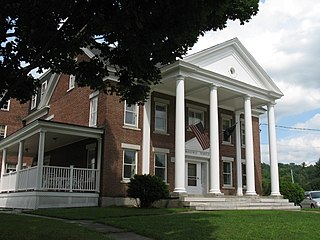
The Barre Downtown Historic District encompasses the historic commercial and civic heart of the city of Barre, Vermont. Extending along Main Street from City Park to Depot Square, this area was developed quite rapidly in the 1880s and 1890s, when the area experienced rapid growth due to the expansion of the nearby granite quarries. It was listed on the National Register of Historic Places in 1979.
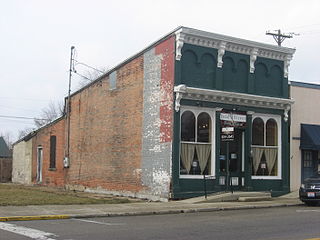
The Village Hobby Shop is a historic building in the village of Mechanicsburg, Ohio, United States. Built on Main Street in the late 19th century, it is one of the village's oldest extant commercial buildings, and it has been named a historic site.

The Bethel Village Historic District encompasses the historic core of the village of Bethel in the town of Bethel, Vermont, USA. The L-shaped district extends along Main and Church Streets, including many of the village's commercial and civic buildings, as well as a significant number of 19th and early 20th-century residences. The district was listed on the National Register of Historic Places in 1976, and was slightly enlarged in 1990.

The Springfield Downtown Historic District encompasses the historic central business district of the town of Springfield, Vermont. Located in a narrow valley on the banks of the Black River, the town's architecture is primarily reflective of its importance as a manufacturing center in the late 19th and early-to-mid 20th centuries, with a cluster of commercial buildings surrounded by residential and industrial areas. It was listed on the National Register of Historic Places in 1983, and enlarged slightly in 1986.

The City Hall Park Historic District encompasses one of the central economic, civic, and public spaces of the city of Burlington, Vermont. Centered on City Hall Park, the area's architecture encapsulates the city's development from a frontier town to an urban commercial center. The district was listed on the National Register of Historic Places in 1983.

The First Federal Savings and Loan Association Building is a historic building located in Downtown Davenport, Iowa, United States. It was individually listed on the Davenport Register of Historic Properties and on the National Register of Historic Places in 2016. In 2020 it was included as a contributing property in the Davenport Downtown Commercial Historic District.
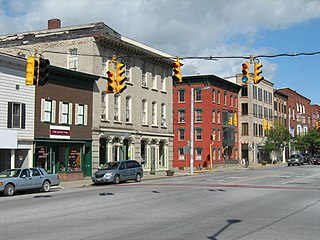
The St. Albans Historic District encompasses most of the historic commercial core of the city of St. Albans, Vermont. The district includes the historic town common, which acts as its focal center, and commercial and civic architecture dating from the early 19th to early 20th centuries. The district was listed on the National Register of Historic Places in 1980.

The Morrisville Historic District encompasses most of the historic commercial downtown area of the village of Morrisville in Morristown, Vermont. Developed in the early 19th century as a service town for the surrounding agricultural areas, it was transformed into a major service regional commercial center by the arrive of the railroad in 1872. Its surviving architecture is largely reflective of these two time periods. It was listed on the National Register of Historic Places in 1983, and enlarged in 2007.

The Newport Downtown Historic District encompasses most of the historic downtown area of the city of Newport, Vermont. The city developed as a transit hub and tourist area in the second half of the 19th century, spurred by the construction of a railroad to the area. The district, roughly bounded by Third Street, Coventry Street, and Lake Memphremagog, was listed on the National Register of Historic Places in 2006.

The Buchanan Downtown Historic District is a primarily commercial historic district located in Buchanan, Michigan between 117 W. and 256 E. Front Street and between 108 and 210-212 Main Street, along with adjacent sections of Oak Street and Days Avenue. The district was listed on the National Register of Historic Places in 2009.
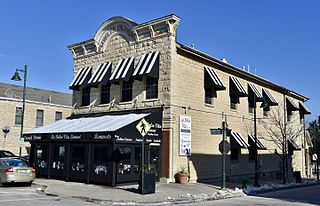
The Lemont Downtown Historic District is a commercial historic district encompassing 14 city blocks in downtown Lemont, Illinois. The district has served as the village's downtown since the 1850s, when the newly opened Illinois & Michigan Canal and subsequent limestone quarrying in the area sparked a local economic boom. It expanded through the late nineteenth and early twentieth centuries as new railroads and the Chicago Sanitary and Ship Canal brought residents and business opportunities to the village. The commercial buildings in the district exhibit a variety of common building types seen between 1850 and 1950; one-part, two-part, gable-front, and false-front buildings are all present, and their designs feature Italianate, Commercial, and revival style architecture. The district also includes several of Lemont's government buildings, including its village hall and post office.

The Downtown Peoria Historic District is a commercial historic district encompassing seventeen city blocks in downtown Peoria, Illinois. The district's buildings reflect Peoria's development as an industrial center and major Illinois city. While Peoria was platted in the 1820s, the oldest buildings in the district date from 1867, shortly before Peoria's economic boom of the 1870s. In the late nineteenth century, Peoria's whiskey industry was among the largest in the world, and many downtown civic improvements and public buildings were funded by whiskey profits. By the turn of the twentieth century, another economic boom brought a large retail district to downtown Peoria; many of the department stores from this period still stand in the district. An urban renewal project in the mid-twentieth century brought several Modernist skyscrapers to downtown Peoria as well, including the Caterpillar administration building, the DeKroff Metz and Company Building, and the First Federal Savings Tower.

The Downtown Rock Island Historic District is a national historic district encompassing 82.3 acres (33.3 ha) in downtown Rock Island, Illinois. The oldest buildings in the district are from the 1860s, two decades after Rock Island's founding, and buildings from then until 1969 can be found in the district, making it reflective of the city's development over time. The majority of the buildings in the district are commercial buildings, as downtown Rock Island has historically been the city's commercial center; these include several building types, mainly one-part and two-part commercial blocks, designed in a wide variety of the architectural styles popular in the late nineteenth and early to mid twentieth centuries. The district was also historically the center of Rock Island's social life, and many theaters and clubhouses for social organizations can be found in the district. Several of Rock Island's major government buildings, including the city hall and old county courthouse, are also part of the district.






















